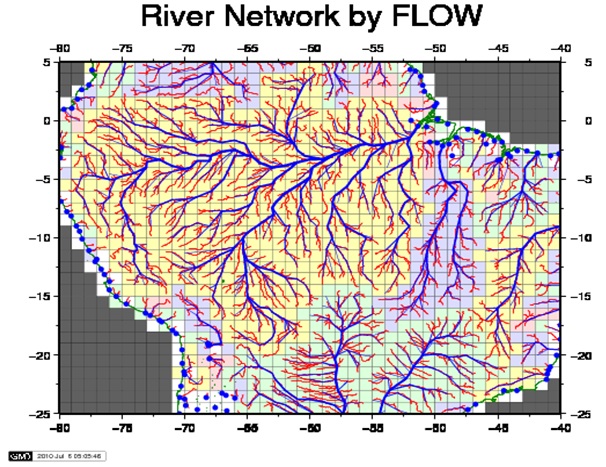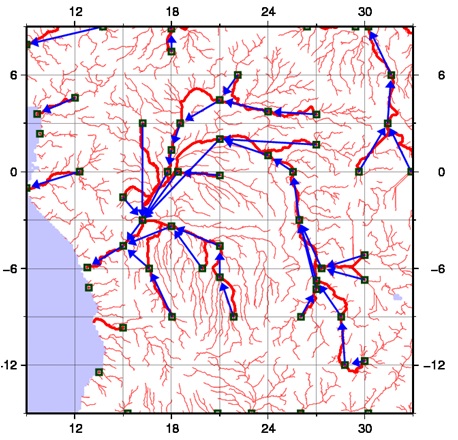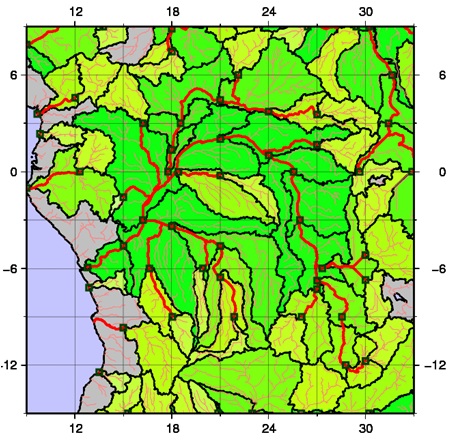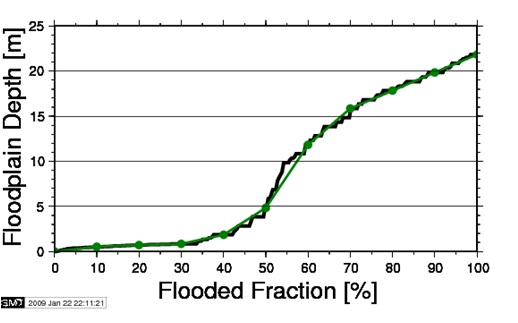Technical Notes
In this page, description of datasets and source codes are written.
Input Data
Description
FLOW method requires two input data. One is a fine-resolution flow direction map, and the other is a fine-resolution DEM. In tar archive, the flow direction map of GDBD (Global Drainage Basin Dataset) [Masutomi et al, 2009] and SRTM30 DEM [NASA] are included. SRTM30 DEM is modified for coordinating with the flow direction map of GDBD. Method for modification is described in the reference paper [Yamazaki, 2010]

GDBD Flow Direction Map (left) and STRM30 DEM (right)
Those datasets are stored in FLOW/data/GDBD/ directory. Datasets are divided by each continent.
| Continent | Asia | Australia | North America | South America | Europe | Africa | Japan | Korea |
| Initial | as | au | na | sa | eu | af | jp | kr |
| ID number | 1 | 2 | 3 | 4 | 5 | 6 | 7 | 8 |
| Suffix | Data | Format |
| .fd | Flow Direction | 4-byte real |
| .elevmod | Elevation | 4-byte real |
| .lonlat | Longitude/Latitude | 4-byte real |
| .uparea | Upstream Drainage Area | 4-byte real |
| .GRDCset | Position of GRDC Station | Text |
All files except GRDCset is plain-binary file. In .fd file, flow direction is indicated by numbers as below:
| 8 | 1 | 2 |
| 7 | 3 | |
| 6 | 5 | 4 |
For example is the flow direction of a grid is indicated by 2, it is the flow toward northeast.
In .lonlat file, longitude is stored in 1st record, while latitude in 2nd record.
Columns in .GRDCset indicates GRDC-ID, X coordinate, Y coordinate, Longitude, Latitude, Upstream Drainage Area.
Please find detailed information in GDBD webpage.
Notice: Endian
All data is prepared in little-endian format. If your system is using big-endian format, you should convert the endian of input data by following steps:
% make conv_endian
% chmod 755 endian.sh
% ./endian.sh
'$FLOW' is your FLOW directory.
Reference
If you use those input datasets for your research, please do not forget to include reference to the dataset: GDBD [Masutomi et al, 2010] and SRTM [NASA].
Development of highly accurate global polygonal drainage basin data
- Masutomi, Y., Y. Inui, K., Takahashi, and U. Matsuoka
Output Data
Data Format
A river network map and its sub-grid topographic parameters are stored in plain-binary format. In case of default 1deg setting, there are 360 grids from west toward east direction starting from (179.5W), and 180 grids from north toward south starting from (89.5N).
| Name | Data | Format |
| nextxy.bin | River Network map | Integer |
| elevtn.bin | Channel Elevation | 4-byte real |
| rivlen.bin | Channel Length | 4-byte real |
| nxtdxt.bin | Distance to downstream grid | 4-byte real |
| grarea.bin | Unit-catchment Area | 4-byte real |
| fldhgt.bin | Floodplain Elevation Profile | 4-byte real |
| GRDCxy.txt | GRDC stations upstream grids | Text |
Downstream grid coordinate is stored in the river network map. X coordinate is stored in 1st record, and Y coordinate is stored in 2nd record.

River network map derived by FLOW (blue).
make_lsmask.F
Land-Sea Mask
In make_lsmask.F, land sea mask is decided. If a gird has a GDBD pixel which has an upstream drainage area larger or equal to 20 km2 (you can change this number by editing 'minarea'), the grid is recognized as land. Continent ID numbers are allocated onto land grids, while 0 is given to sea grids.
const_network.F
In const_network.F, a river network map, channel altitude, channel length, and distance to downstream grid is decided.
Outlet Pixels and Channel Elevation
First, the outlet pixel of each grid-box is decided. The GDBD pixels with flow direction toward neighboring grid-box are chosen as potential outlet pixels. The potential outlet pixel with maximum upstream drainage area is selected for each grid, and the distance toward the selected potential outlet pixel of downstream grid is calculated. If the distance is smaller than the threshold value (default is 50 km, you can change the threshold by editing '_dst_min_' in 'define.h'), the selected potential outlet pixel is rejected. In case there is no other potential outlet pixel in the grid-box, then the selected outlet pixel in downstream grid-box is rejected. Minimum distance should be given in order to reduce the instability related to CFL condition in a river routing model.
Then, the potential outlet pixel with maximum upstream drainage area but not rejected in the previous step is selected for each grid, and the distance toward the selected potential outlet pixel of downstream grid is calculated. This step is repeated until the condition of minimum distance is satisfied in all grid-boxes.
When the condition of minimum distance is satisfied, the potential outlet pixels selected at the time are finally decided as outlet pixels. And, the elevation of the outlet GDBD pixel of each grid is decided as the channel elevation of the grid. Outlet pixels are marked with small green squares in the figure below.
River Network Map
Second, the fine-resolution river channel of GDBD was traced from the outlet pixel of a target cell until it reached the next outlet pixel downstream. The coarse-resolution cell where the next outlet pixel was located was determined to be the downstream cell of the target cell (the downstream cell of each cell is indicated with a blue vector in the figure below). Note that the downstream cell was not necessarily selected from the eight cells neighboring the target cell, but was located on any cell. The exception was if the traced river channel reached a coastal pixel of GDBD, then the target cell was recognized as a river mouth cell.
Channel Length and Distance to Downstream Grid
Third, the channel length of each cell was determined as the length of the fine-resolution river channel between the outlet pixels of the cell and its upstream cell (bold river channels within each unit-catchment in the figure below). Where multiple upstream cells exist for one cell, the upstream outlet pixel with largest drainage area was chosen as the representative upstream outlet pixel. For headwater cells with no upstream cell, channel length was given as a half-length of the cell size. Similarly, distance to a downstream grid point, X, was decided as the length of the fine-resolution river channel meandering between the outlet pixels of the cell and its downstream cells.

The constructed river network map. The downstream grid of each grid is indicated with a blue vector. Outlet pixels are marked with small green squares.
define_catchment.F
In define_catchment.F, unit-catchment area and floodplain elevation profile is decided.
Unit-catchment area
First, the group of GDBD pixels that drained into the outlet pixel of each cell was determined as the unit-catchment pixels of the cell (Pixels divided by black boundaries in the figure below). The total area of the unit-catchment pixels for each cell was determined as the catchment area, Ac, for the cell.

Unit-catchment for each grid.
Floodplain Elevation Profile
The cumulative distribution function (CDF) of the elevation within each unit-catchment was taken to describe the floodplain elevation profile (see the bold grey line in the figure below). This CDF describes the relationship between a flooded area and floodplain water depth. Every tenth percentile of CDF (dots in the figure) was extracted, and the line connecting these points (sharp line in the figure) was determined as a function to describe the floodplain elevation profile. The 10th percentile value is stored in 1st record, the 20th percentiles is stored in 2nd record, and so on until the 100th percentile is stored in 10th record of 'fldhgt.bin'.

Floodplain elevation profile.
combine_area.F
Combine continental maps to the global map
In combine_area.F, upscaled maps in '$FLOW/1deg/data/' for each continent is aggregated into global maps in '$FLOW/1deg/map/'.
set_map.F
Calculate supplemental maps
In set_map.F, supplemental maps related to the upscaled river network map are generated. Those maps are used for illustration in the next section, or simulation with rectangular grid box in CaMa-Flood instead of an unit-catchment approach.
| Name | Data | Format |
| rivseq.bin | # of grids from far most headwater | Integer |
| grarea_grid.bin | Rectangular Grid-box Area | 4-byte real |
| uparea.bin | Upstream drainage area (Unit-catchment based) | 4-byte real |
| uparea_grid.bin | Upstream drainage area (Rectangular grid-box based) | 4-byte real |
| nxtdxt_grid.bin | Distance between centers of upstream and downstream cells | 4-byte real |
| lonlat.bin | Longitude/Latitude of outlet pixels | 4-byte real |
| basin.bin | River Basin ID | 4-byte real |
| bsncol.bin | Color of River Basin for Illustrating | 4-byte real |
station.F
GRDC gauging stations
In station.F, upstream grids of each GRDC gauging station is listed up. For example in the figure below, upstream grids of the gauging station (Light blue square) are decided as grids (b) and (d).

Upstream grids of a GRDC gauging station.